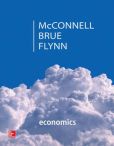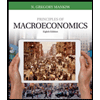
Economics: Principles, Problems, & Policies (McGraw-Hill Series in Economics) - Standalone book
20th Edition
ISBN: 9780078021756
Author: McConnell, Campbell R.; Brue, Stanley L.; Flynn Dr., Sean Masaki
Publisher: McGraw-Hill Education
expand_more
expand_more
format_list_bulleted
Question
Chapter 36, Problem 1DQ
To determine
The differences between the short run and the long run in macroeconomics .
Expert Solution & Answer
Explanation of Solution
Differences between the short run and the long run in macroeconomics:
- 1. In the short run, input prices do not respond to the change in the
price level. That is, input prices are inflexible. In the long run, however, input prices are flexible.
- 2. In the long run, the economy will adjust itself. That is, there is no need of government intervention. But in the short run, fiscal and
monetary policies are required to stabilize the economy.
The distinction between the short run and the long run is important to have better analysis of short run and long run aspects.
Economics Concept Introduction
Concept introduction:
Short run: Short run refers to the time period which does not allow the change in capital to adjust with the market situation.
Long run: Long run refers to the time period which allows the change in capital to adjust with the market situation.
Want to see more full solutions like this?
Subscribe now to access step-by-step solutions to millions of textbook problems written by subject matter experts!
Students have asked these similar questions
3. Consider the market for paper. The process of producing paper creates pollution. Assume that
the marginal damage function for pollution is given by:
MDF = 3E
where damages are measured in dollars and E is the level of emissions. Assume further that the
function describing the marginal abatement cost of emissions is given by
MAC 120-E
where benefits are measured in dollars and E is the level of emissions.
a. Graph the marginal damage function (MDF) and the marginal abatement cost function
(MAC).
b. What is the unregulated level of emissions Eu? What is the social welfare of this emissions
level?
c. Assume an existing emission quota limits emissions to E = 60. Show on the graph why this
policy is inefficient. What is the deadweight loss caused by this policy?
show written calculation for B
Problem 1:
1. If a stock is expected to pay an annual dividend of $20 forever, what is the approximate
present value of the stock, given that the discount rate is 5%?
2. If a stock is expected to pay an annual dividend of $20 forever, what is the approximate
present value of the stock, given that the discount rate is 8%?
3. If a stock is expected to pay an annual dividend of $20 this year, what is the approximate
present value of the stock, given that the discount rate is 8% and dividends are expected to
grow at a rate of 2% per year?
Chapter 36 Solutions
Economics: Principles, Problems, & Policies (McGraw-Hill Series in Economics) - Standalone book
Knowledge Booster
Similar questions
- d-farrow_forwardG please!arrow_forward4. Consider two polluting firms, with the marginal abatement costs of polluters 1 and 2, respectively, equal to MAC₁ = 20-E1 MAC2 = 12-E2 a. What is the unregulated level of pollution for each firm? b. Assume policymakers have decided to cut the level of pollution in half. The way they intend to accomplish this goal is to require both firms to cut their pollution in half. What are the total costs of abatement from the policy? And how are these costs distributed between the firms? c. Is this uniform quota on emissions across firms the most cost-effective manner in which to reduce emissions by 50%?arrow_forward
- Don't used hand raiting and don't used Ai solutionarrow_forwardThanks in advance!arrow_forwardI need help figuring this out. I'm pretty sure this is correct?If Zambia is open to international trade in oranges without any restrictions, it will import 180 tons of oranges.I can't figure these two out: 1) Suppose the Zambian government wants to reduce imports to exactly 60 tons of oranges to help domestic producers. A tariff of ???? per ton will achieve this. 2) A tariff set at this level would raise ????in revenue for the Zambian government.arrow_forward
- 16:10 ← BEC 3701 - Assignments-... KWAME NKRUMAH UNIVERSITY TEACHING FOR EXCELLENCE SCHOOL OF BUSINESS STUDIES DEPARTMENT OF ECONOMICS AND FINANCE ADVANCED MICRO-ECONOMICS (BEC 3701) Assignments INSTRUCTIONS: Check instructions below: LTE 1) Let u(q1,q2) = ln q₁ + q2 be the (direct) utility function, where q₁ and q2the two goods. Denote P₁ and P2 as the prices of those two goods and let M be per period money income. Derive each of the following: a) the ordinary or Marshallian demand functions q₁ = d₂ (P₁, P₂, M) for i = 1,2 [3 Marks] b) the compensated or Hicksian demand functions q₁ = h₂ (P₁, P2, M) for i = 1,2 [3 Marks] c) the Indirect Utility Function uº = v(P₁, P2, M) [3 Marks] d) the Expenditure Function E(P1, P2, U°) [3 Marks] e) Draw a diagram of the solution. There should be two graphs, one above the other; the first containing the indifference curves and budget constraint that characterize the solution to the consumer's choice problem; the second characterizing the demand…arrow_forwardHow would you answer the question in the News Wire “Future Living Standards”? Why?arrow_forwardal Problems (v) T (ix) F 1. Out of total number of 2807 women, who were interviewed for employment in a textile factory, 912 were from textile areas and the rest from non-textile areas. Amongst the married women, who belonged to textile areas, 347 were having some work experience and 173 did not have work experience, while for non-textile areas the corresponding figures were 199 and 670 respectively. The total number of women having no experience was 1841 of whom 311 resided in textile areas. Of the total number of women, 1418 were unmarried and of these the number of women having experience in the textile and non-textile areas was 254 and 166 respectively. Tabulate the above information. [CA. (Foundation), May 2000 Exactly (14) of the total employees of a sugar mill were these were married and one-halfarrow_forward
- How did Jennifer Lopez use free enterprise to become successful ?arrow_forwardAn actuary analyzes a company’s annual personal auto claims, M and annual commercialauto claims, N . The analysis reveals that V ar(M ) = 1600, V ar(N ) = 900, and thecorrelation between M and N is ρ = 0.64. Compute V ar(M + N ).arrow_forwardDon't used hand raitingarrow_forward
arrow_back_ios
SEE MORE QUESTIONS
arrow_forward_ios
Recommended textbooks for you
 Exploring EconomicsEconomicsISBN:9781544336329Author:Robert L. SextonPublisher:SAGE Publications, Inc
Exploring EconomicsEconomicsISBN:9781544336329Author:Robert L. SextonPublisher:SAGE Publications, Inc Essentials of Economics (MindTap Course List)EconomicsISBN:9781337091992Author:N. Gregory MankiwPublisher:Cengage Learning
Essentials of Economics (MindTap Course List)EconomicsISBN:9781337091992Author:N. Gregory MankiwPublisher:Cengage Learning Principles of Economics (MindTap Course List)EconomicsISBN:9781305585126Author:N. Gregory MankiwPublisher:Cengage Learning
Principles of Economics (MindTap Course List)EconomicsISBN:9781305585126Author:N. Gregory MankiwPublisher:Cengage Learning Brief Principles of Macroeconomics (MindTap Cours...EconomicsISBN:9781337091985Author:N. Gregory MankiwPublisher:Cengage Learning
Brief Principles of Macroeconomics (MindTap Cours...EconomicsISBN:9781337091985Author:N. Gregory MankiwPublisher:Cengage Learning Principles of Macroeconomics (MindTap Course List)EconomicsISBN:9781305971509Author:N. Gregory MankiwPublisher:Cengage Learning
Principles of Macroeconomics (MindTap Course List)EconomicsISBN:9781305971509Author:N. Gregory MankiwPublisher:Cengage Learning

Exploring Economics
Economics
ISBN:9781544336329
Author:Robert L. Sexton
Publisher:SAGE Publications, Inc

Essentials of Economics (MindTap Course List)
Economics
ISBN:9781337091992
Author:N. Gregory Mankiw
Publisher:Cengage Learning

Principles of Economics (MindTap Course List)
Economics
ISBN:9781305585126
Author:N. Gregory Mankiw
Publisher:Cengage Learning

Brief Principles of Macroeconomics (MindTap Cours...
Economics
ISBN:9781337091985
Author:N. Gregory Mankiw
Publisher:Cengage Learning

Principles of Macroeconomics (MindTap Course List)
Economics
ISBN:9781305971509
Author:N. Gregory Mankiw
Publisher:Cengage Learning
